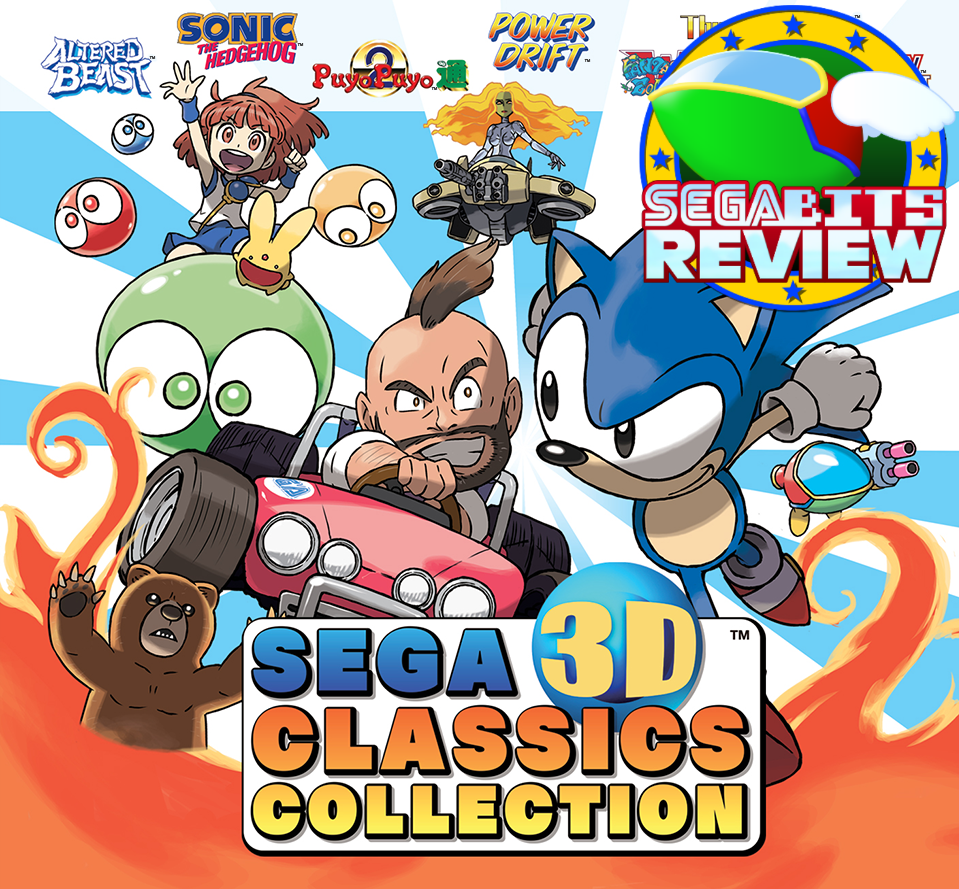
SEGA 3D Classics Collection is the latest in the long line of compilations that SEGA loves to produce. For years the company has to rereleased various titles in a neat packages for convenience, often times Genesis titles from the golden days. Examples include both Sonic Mega Collection and Sonic Gems Collection, SEGA Genesis Collection, and SEGA Smash Pack. However, few of these compilations were released on handheld systems, and often times arcade games would get the short end of the stick. So SEGA 3D Classics Collection is a bit special in this case since it has several games that you don’t normally see in these compilations like Power Drift, Puyo Puyo Tsu, and Maze Walker.
The concept of remaking old games using the 3D capabilities of the 3DS in mind originally began as a series of Nintendo 3D Classics titles during 2011-2012 when the system was young. Games part of this series included Kirby’s Adventure 3D Classics and Kid Icarus 3D Classics, and they were developed simply as novelties to see games in 3D. After 2012 though, Nintendo stopped producing these type of games, but luckily SEGA picked up the slack from where Nintendo stopped starting in 2013 with their own 3D series of titles. In conjunction with development studio M2, SEGA released SEGA Genesis and arcade titles with not only 3D effects, but other options to keep the games fresh like the ability to adjust difficulty, change region, change the resolution, or use optional gyro controls. All this could be had on the Nintendo eShop for the average price of $6.
Eventually these titles would be rereleased on special retail compilations in Japan called SEGA Reprint Archives, with several bonus titles exclusive to these bundles. Currently there are two volumes in this series, with SEGA 3D Classics Collection being based on the 2nd volume originally released in 2015. There are a total of 9 games comprising of arcade, SEGA Genesis, and Master System titles. Exclusive to SEGA 3D Classics Collection is Power Drift, Puyo Puyo Tsu, Fantasy Zone II: The Tears of Opa-Opa, and Maze Walker, with Fantasy Zone II W, Sonic the Hedgehog, Thunder Blade, Galaxy Force II, and Altered Beast also included.
General
- All games comes with the option to use either the circle pad or the directional pad. I personally recommend using the circle pad for Power Drift, Galaxy Force II, Thunder Blade, Fantasy Zone II, and Fantasy Zone II W, while using the directional pad for Puyo Puyo Tsu, Sonic the Hedgehog, Maze Walker, and Altered Beast. But it’s up to preference.
- Several games come with a sound test, including Power Drift and Puyo Puyo Tsu.
- All games in SEGA 3D Classics Collection allows the player to customize their button settings to whatever they feel comfortable with.
- The player can switch between games on any of the game’s menu screens without returning to the title screen by pressing Game Select. There’s also an option to return to the main menu.
- Professor Asobin will provide a tip or trivia on the loading screen between games.
- Most games in SEGA 3D Classics Collection, with the exception of Puyo Puyo Tsu and Fantasy Zone II W, allows the player to switch between an International (English) and Japan version.
- There’s a save sate system that allows the player to save whenever they want.
- All games in SEGA 3D Classics Collection allows the player to restart as an option.
- There’s an option to record the last play session as a replay.
- The Master System games allow the players to switch between the FM Sound Unit used in Japanese versions of Master System games or the PGS sound used internationally.
- Various games have a difficulty setting that makes games easier or harder.
Power Drift
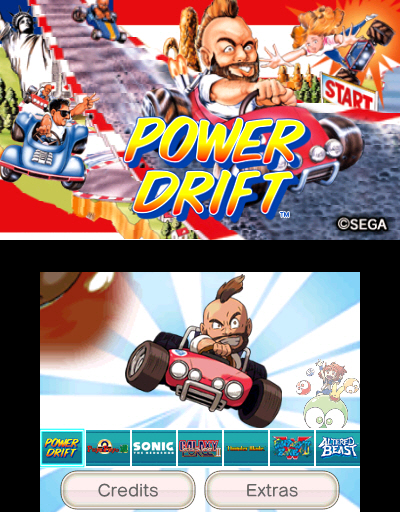
One of the exclusive titles to SEGA 3D Classics Collection, Power Drift was originally released as an arcade game in 1988 in Japan only, with a few ports on home computers later in PAL territories only. The most notable feature of this game is the frantic pacing, and the many twists and turns taking advantage of SEGA’s Super Scaler chipset to create pseudo-3D by manipulating sprites at a high rate. Combine both and this game makes F-Zero look like Hard Drivin’. The game consists of 5 different tracks with each having a set of 5 stages, with an extra 6th stage if the player manages to get 1st on every other stage. The objective with each course is to get 1st, 2nd, or 3rd in a race, with a limit of 3 credits per game, and once all credits are used up the game is over. The player has the option to shift between a high gear and a low gear, with the high gear causing your driver to move super fast while the low gear slows you down, ideal for sharp turns. Hitting other drivers, objects like houses or trees, or falling off the course will drastically slow you down, so when combined with the blazing fast speeds don’t be surprised if you fail several times in a given stage.
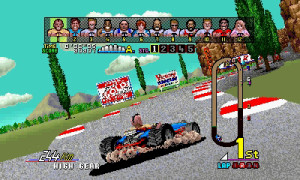 The 3D aspect in this game is a mixed bag. Technically speaking the 3D effect is amazing with everything having deep depth with every sprite and even certain HUD graphics having a slight pop effect. The main problem though is that it’s very disorienting due to the fast paced nature of this game, so despite how incredible it looks it’s not practical for the type of game Power Drift is. This version comes with a difficulty setting in the options and ways to switch between high gear and low gear, so if the game is (justifiably) hard for you, you have the option to adjust the settings for a smoother experience, or make it hair ripping brutal. The game can be hard to swallow at first, but once you get used to how it plays it’s satisfying to hear your driver blaze past the others while yelling “Eat dirt slowpoke!”
The 3D aspect in this game is a mixed bag. Technically speaking the 3D effect is amazing with everything having deep depth with every sprite and even certain HUD graphics having a slight pop effect. The main problem though is that it’s very disorienting due to the fast paced nature of this game, so despite how incredible it looks it’s not practical for the type of game Power Drift is. This version comes with a difficulty setting in the options and ways to switch between high gear and low gear, so if the game is (justifiably) hard for you, you have the option to adjust the settings for a smoother experience, or make it hair ripping brutal. The game can be hard to swallow at first, but once you get used to how it plays it’s satisfying to hear your driver blaze past the others while yelling “Eat dirt slowpoke!”
Puyo Puyo Tsu

Another exclusive to SEGA 3D Classics Collection, Puyo Puyo Tsu is the sequel to the first arcade title Puyo Puyo and on of the more notable titles in the Puyo Puyo franchise as a whole. The game is a popular competitive game in Japan due its focus on multiplayer, along with introducing standard features for this game and future titles like Offsetting, Margin Time, and All Clear. The game contains a single player mode and a multiplayer mode, notably being one of only two games in this compilation that has Local Play. In single player mode, you’re playing in the role as the heroine Arle Nadja, as you’re tasked with climbing the tower in order to confront Satan. But before Arle faces Satan, she must face different opponents (technically 32!) via a roulette, and earn enough points to climb up the tower. The difficulty increases with each floor, and there’s also a hidden final boss that is encountered without using a continue, so mastering this game is not easy.
 The multiplayer is probably it’s strongest feature though. Between two players, you’re tasked with burying your opponent with Nuisance Puyo by setting off chains. But be warned, if the 3rd column and 12th row spot is occupied, you’re knocked out. Introduced in this game is the ability to Offset, allowing you to clear or even counter Nuisance Puyo before they drop with your own chains. All Clear, which is a bonus when you clear your board, in this case 30 additional Nuisance Puyo given when setting off the next chain. Also Margin Time, which is a hidden point system that increases the Nuisance Puyo multiplier if matches drag on too long. The game also provides you with an assortment of gimmicks if you want to experiment with something different.
The multiplayer is probably it’s strongest feature though. Between two players, you’re tasked with burying your opponent with Nuisance Puyo by setting off chains. But be warned, if the 3rd column and 12th row spot is occupied, you’re knocked out. Introduced in this game is the ability to Offset, allowing you to clear or even counter Nuisance Puyo before they drop with your own chains. All Clear, which is a bonus when you clear your board, in this case 30 additional Nuisance Puyo given when setting off the next chain. Also Margin Time, which is a hidden point system that increases the Nuisance Puyo multiplier if matches drag on too long. The game also provides you with an assortment of gimmicks if you want to experiment with something different.
The 3D effects in Puyo Puyo Tsu is simple depth perception, with the exception of special effects like Puyo popping having a pop-out effect. The introduction is probably the best usage of the 3D effects, with Arle and the others having good depth. Players have the option to adjust the difficulty settings, including an exclusive “Very Easy” option, and the ability to adjust the round numbers in a multiplayer match, adjust the Margin Time, and toggle between having Offsetting or not. Single player is a fine experience if you’re the type of person that wants the best score, but I strongly recommend getting a friend to play with since the strength of this game is in it’s multiplayer. The game itself is sadly bare otherwise, especially compared to other versions of Puyo Puyo Tsu like Puyo Puyo Tsu on the SEGA Saturn and Playstation.
If you want to learn more about this game, a convenient user’s guide has been made with how the game works.
Sonic the Hedgehog
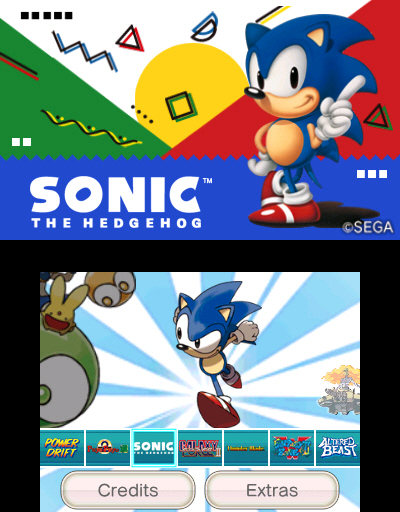
Sonic has had man ups and downs over the years, but when in doubt it doesn’t hurt to go back from the beginning to play his first game. Sonic the Hedgehog is a solid enough start for the famous blue hedgehog that would establish many of familiar characteristics like his fast speeds and the ability to curl up into a ball. Though being the first installment, there are a few rough areas that later games fix. There is a lot of slowing down compared to later titles so there’s more of an emphasis on platforming, most apparent with Marble Zone and the infamous Labyrinth Zone. The boss fights with Dr. Eggman are also pretty lackluster. Still, Sonic the Hedgehog is a solid platforming game that has its significance and nostalgia.
Sonic the Hedgehog is a common game that is ported to several systems, though the handheld versions tend to suffer from different problems. The infamous Sonic the Hedgehog Genesis on GBA suffers from buggy physics and slowdown, the Sonic Classic Collection has choppy framerates, and Sonic the Hedgehog on mobile has the general problem with touch controls being impractical. Thankfully 3D Sonic the Hedgehog is a faithful version, with only minor graphic glitches and slowdown from the occasional crowding. This version includes the option to use the Spin Dash similar to versions in Sonic Jam or Sonic the Hedgehog on mobile, and the option to use a stage select. The 3D effects though are nothing special.
Fantasy Zone II W: The Tears of Opa-Opa
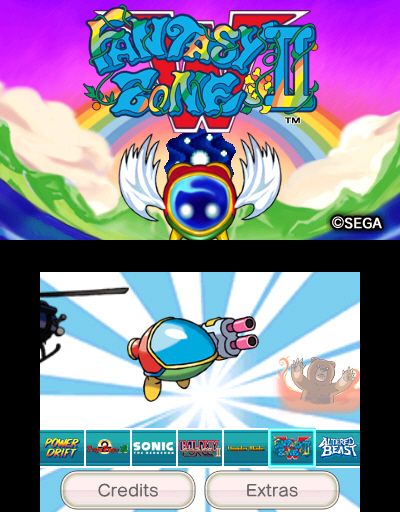
Fantasy Zone II W (Also known as Fantasy Zone II DX) is a special version of Fantasy Zone II designed by M2 as a hypothetical arcade game using System 16 hardware, originally released for SEGA Ages Vol. 33 Fantasy Zone Complete Collection. In this game you play as the adorable spaceship Opa-Opa, as your tasked with gunning down enemies that act as bases throughout the area, and afterwards fight a boss. In typical Fantasy Zone fashion there is not auto scrolling like in a vein to Gradius, instead you fly and shoot in an area and can move wherever in a loop. As you gun down enemies, you’ll earn coins, which can be used in shops in order to upgrade Opa-Opa, with upgrades ranging from wings or engines making Opa-Opa move faster, various types of guns like lasers and spread shots, different kinds of bombs, and late in the game the titular Tears of Opa-Opa. Despite the game’s cute colorful appearance, the game has a spine that can throw off people, mainly because Opa-Opa is instantly killed with a single hit unless he’s equipped with an upgraded weapon and his upgrades have limited usage.
The main difference between the two versions of Fantasy Zone II is that Fantasy Zone II W uses a different system with the warp feature. In Fantasy Zone II W there are two versions of each stage, a Bright Side and a Dark Side. The Bright Side acts as the normal stage where you play in typical Fantasy Zone fashion. In the Dark Side however the game becomes harder, shops are hidden, and you receive more coins. The game keeps track of all the money you collect in a deposit, which you can withdraw from when you replay a stage. The game also keeps track of which side you clear in a morality system, causing multiple endings. If you focus on the Bright Side, Opa-Opa will become corrupted and start destroying the Fantasy Zone only to be eventually destroyed himself, while if you focus on the Dark Side Opa-Opa will instead remain good and save the Fantasy Zone once again. If you beat the game with the Opa-Opa Tears, it will cause the best ending, though achieving this is difficult due to the extreme price of the Opa-Opa Tears.
Fantasy Zone II W also has an additional Endless mode, where the player as Upa-Upa is equipped with big wings, twin bombs, and a 3-spread shot and you’re tasked with simply trying to go as far as possible for a high score. The farther you go, the more difficult it gets, with the game eventually getting flooded with so many bullets and enemies that it’s sadistic. If you get shot once, you’ll lose the 3-spread shot but can retrieve it again from a special pod. But if you have the patience and endure the onslaught, you can instead get a special weapon that swamps the entire field in bullets. Though a fun mode in itself, it’s also useful for grinding for money.
Unique to this game is unlockable cheats. 30,000 coins in the deposit unlocks Shop Markers, which reveals the location of hidden shops in the Dark Side. 60,000 coins unlocks Weapon Extend, which increases the duration of upgraded weapons. 120,000 coins unlocks Gold Rush, which causes coins to drop more often. Otherwise the game itself does an acceptable job with the 3D effects. Despite not being an exclusive title, Fantasy Zone II W is still one of the best titles on the collection.
Want another reviewer’s take? See what George had to say in his review of 3D Fantasy Zone II.
Thunder Blade
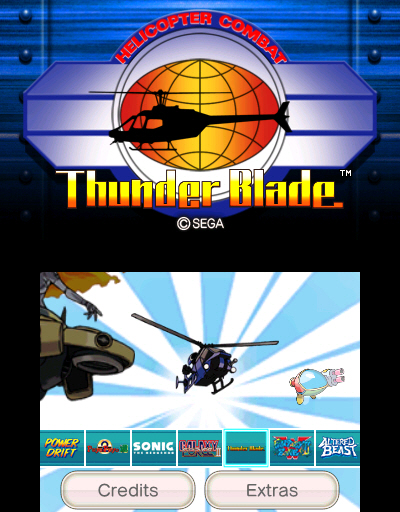
Thunder Blade is a shooting game originally released to arcades in 1987 where you take on the role of an attack helicopter called the Thunder Blade. In this game you’re tasked with gunning down tanks, jets, helicopters, and battleships to earn the highest score and survive through 4 stages. You’re only armed with two weapons, a straight forward gun that fires forward at a fast pace and missiles that have a large blast radius but a slow rate of fire. Each stage is divided into 3 segments, a bird’s eye view where you can ascend and descend, a forward view, and a “boss” fight with a battleship or something similar. You’re helicopter the Thunder Blade is very fragile though, being instantly destroyed if it touches anything with no power ups to compensate.
The main problems with this game is that it’s very short, it’s not as punishing as some of it’s kin especially since you’re given 3 credits, and the controls can be a bit clumsy if you’re not used to them, most obvious during the beginning stages with the bird’s eye view, though that can be adjusted with the settings. Thunder Blade uses the 3D well, and it actually have some gameplay benefits since it gives you a better judgement of prospective with the projectiles. The game’s difficulty on the lowest setting prevents the Thunder Blade from being destroyed by walls. Players also have the option to toggle inverted controls for ascending and descending.
Check out what Barry had to say in his review of 3D Thunder Blade.
Galaxy Force II
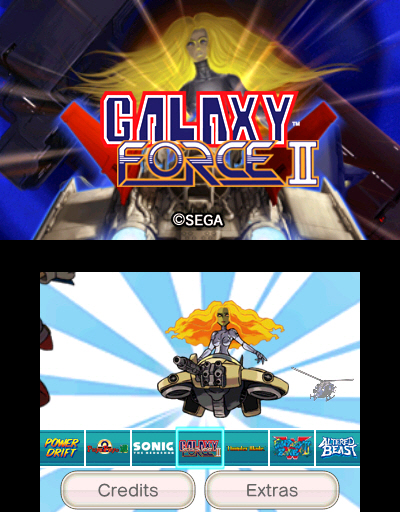
Galaxy Force II is a shooter arcade game originally released in 1988. Contrary to what the title may say, Galaxy Force II is not a sequel, but an updated special edition of the original Galaxy Force. You control the fighter-ship TRY-Z with you’re tasked to destroy the Fourth Empire ruled by Halcyon. Similar to something like Panzer Dragoon your main two weapons are a straight forward gun that has decent fire rate, and a lock-on system where if enemies or objects are highlighted with a cursor where you can shot them down with homing missiles. There are a total of 6 stages, with segments where you fly in an open area, infiltrate an enemy base, and destroy the core. Sometimes the player is also given the option of multiple paths.
The greatest threat in the entire game is your own fuel gauge. Your fuel will constantly drain as you’re flying, and if you lose all your fuel the game is over. Further complicating this is that hitting objects will slow you down considerably, and if your shield breaks hazards will also start to drain your fuel. Because of the threat of the fuel, you’ll have to master how to use the breaks and throttle. Most of the time you’ll need to use the throttle so you reach the end or checkpoints as fast as possible, but you’ll also need to occasionally use the brakes to slow down and make sharp turns. Luckily Galaxy Force II is generous with telling you when to turn by yelling “Turn left!” or “Turn right!” respectively. Naturally being an arcade game, the game won’t make it easy to reach the end unscathed, as everything will try to stop you. Memorizing everything is key to survive the hellish courses.
Similar to Thunder Blade, the 3D effects can benefit the player since the prospective of objects becomes more obvious, but since the game is more fast paced it may be more impractical. Players also have the option to toggle between inverted controls. If the difficulty of the game is too much or if the player want’s a harder challenge, there are options to adjust how fast your fuel drains, the fuel you start with, and how durable your shield is.
Altered Beast
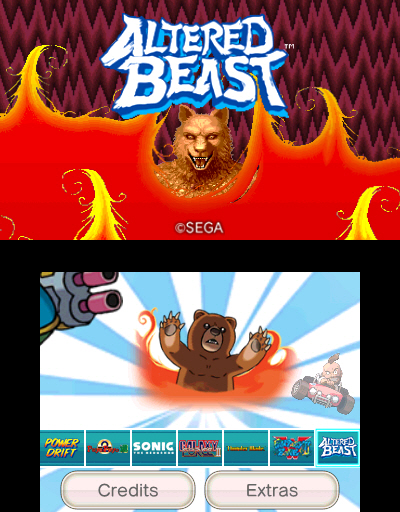
“WELCOME TO YOUR DOOM!!”
Which sadly sort of describes this game. Altered Beast was released in 1988 for arcades and later ported onto the SEGA Genesis. The game is pretty mediocre though, especially when compared to the beat ’em ups SEGA would later produce like Golden Axe and Streets of Rage. The game begins with the infamous “WISE FWOM YOU GWAVE” as you rise up to start beating up all sorts of monsters… very… slowly. Armed with a kick and punch along with a few impractical attacks like a upwards kick that’s useless, you must defeat specific enemies (typically wolves) to spawn a Spirit Ball that will make you “POWER UP!” and get stronger. Once you earn enough of these Spirit Balls you’ll transform into 5 different beasts, a werewolf, a dragon, a bear, a tiger, and a golden werewolf. Once you turn into the beast form, you can face the end stage boss. Technically you can face the boss without being the beast form if you fail to retrieve it after a few cycles, but fighting the boss as a human is a very suicidal idea. There are 5 stages total of slowly and awkwardly killing monsters and powering up, so have fun!
The game is honestly the weakest of the games in SEGA 3D Classics Collection. The slow pacing and limited attacks causes the game to be rather dull, not helped by the attacks while human are impractical and enemies liking to swarm you. Altered Beast also has bad music and mediocre visuals, with the 3D effects being rather weak. The options for the game are nothing special either, with only a “Random Form” option being notable. Despite the nostalgia the game has with people, there are better options then this game they could of put on the collection. But at least it has co-op and is one of only two games in the collection that has multiplayer, so that’s something I guess.
Fantasy Zone II: The Tears of Opa-Opa
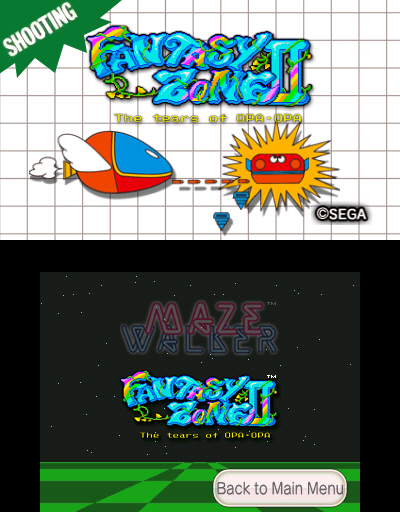
The original Master System version of Fantasy Zone II is regarded as the “inferior” version to the later Fantasy Zone II W, but it’s still a decent game in it’s own right. You control Opa-Opa as you’re tasked with shooting down specific enemies that act as bases while collecting power ups with coins to strengthen Opa-Opa. Unlike the later Fantasy Zone II W, the game handles warps as essentially different areas in each level. To reach every base you’ll need to warp between areas and shoot down the enemy bases, with specific ones unlocking more warps when defeated. Each warp is conveniently labeled with a number, and there’s a specific red warp that leads to the boss of the area once all bases are destroyed. Keep in mind that sometimes a warp you want won’t be the same area, so you might have to backtrack to another area, which can get a bit annoying.
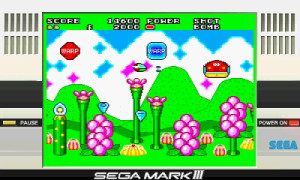
Unlike Fantasy Zone II W, Opa-Opa does have a life bar, albeit a limited one that still makes Opa-Opa fragile. The warps themselves are predetermined in each stage, so you can form a route to get the most efficiency out of the game. There’s no morality system in Fantasy Zone II or save feature, and obviously the graphics and sound are a step down but still generally good. Overall the game is more simple, which might be a benefit or hindrance depending on your views, but Fantasy Zone II still holds on it’s own due to how it has it’s own set of rules. Like Fantasy Zone II W, the 3D effects are acceptable.
Maze Walker

Maze Walker (also known as Maze Hunter 3D) was a Master System game and one of the few that took advantage of the Master System’s SegaScope 3D glasses. You play as an unnamed human who must navigate labyrinths in an alien world, only armed with an Iron Bar as your weapon of choice. The Iron Bar is absolutely needed since it allows you to defend yourself against strange aliens and open question mark panels to reveal new items. Occasionally a red dot will hover in the air, which will reveal a power up like a projectile. There are a total of 5 areas with 4 rounds in each act, with the goal to find the silver key and find the exit.
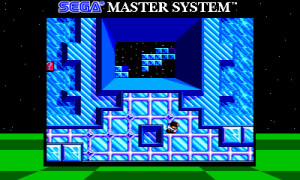 The flaws with the game itself is that it’s very slow, with no run button or any sort of equivalent. This becomes more apparent in later stages, where you’ll have to backtrack when you get the key back to the exit. The Iron Bar weapon is also a flawed weapon, since it has limited range and some of the enemies can be rather fast or erratic with their patterns, most notably in narrow hallways. The Iron Bar is also something you need to pick up every time you die, and you absolutely need the Iron Bar in order to find the silver key to progress. While there are power ups in the game, they don’t affect you much, for example the Power Boots allows you jump on enemies and the roller skates allow you to stay in the air longer. This is also the type of game where you die in one hit with no compensation, so expect to die a good amount.
The flaws with the game itself is that it’s very slow, with no run button or any sort of equivalent. This becomes more apparent in later stages, where you’ll have to backtrack when you get the key back to the exit. The Iron Bar weapon is also a flawed weapon, since it has limited range and some of the enemies can be rather fast or erratic with their patterns, most notably in narrow hallways. The Iron Bar is also something you need to pick up every time you die, and you absolutely need the Iron Bar in order to find the silver key to progress. While there are power ups in the game, they don’t affect you much, for example the Power Boots allows you jump on enemies and the roller skates allow you to stay in the air longer. This is also the type of game where you die in one hit with no compensation, so expect to die a good amount.
However, the best part about the game is easily the 3D effects. Maze Walker was built with the 3D in mind, so naturally a lot of stuff has a great amount of depth and pop. For example when your character jumps he looks like he’s actually jumping, the levels have different floors and likewise sprites shrink or grow to further emphasize this, walls are apparent, and the occasional red dot floating above or death animation looks like you can actually touch it. The only downside to the 3D is that there’s only two modes of 3D, all or nothing, which may bother people that have a specific sweetspot. Sadly while the actual 3D is great, this is one of the weaker titles in SEGA 3D Classics Collection otherwise.
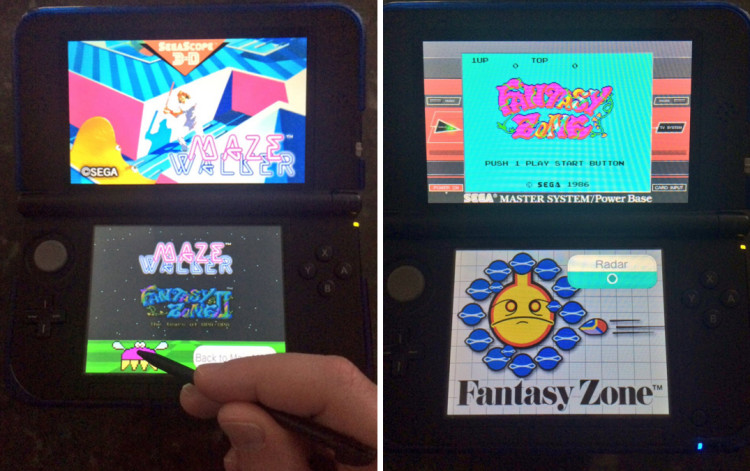
UPDATE: Following the release of SEGA 3D Classics Collection, another bonus game has been discovered. The Master System version of Fantasy Zone is indeed present in the game. To unlock it, simply go to the Extras menu and tap in the lower left corner. A Fantasy Zone enemy should then appear next to the “Back to Main Menu” button and take you to the Master System version of Fantasy Zone. From here on out, you can access the bonus game via the game select menu and the Extras menu.
Overall this is a decent package of games. Most games are worth checking out since the games are normally not found in these SEGA compilations, and even if that doesn’t interest you, it’s a bargain to have SEGA 3D games in one convenient package. The main problem with SEGA 3D Classics Collection isn’t the selection, but the quantity. Compared to other compilations SEGA has released which can have dozens of games on them, there’s only 9 here, so if you do buy this particular collection remember to take advantage of it’s strengths, like the 3D effects and exclusives like Power Drift and Puyo Puyo Tsu.
Positive:
- Multiple games including some uncommon ones
- Customization allows for flexibility and accessibility
- Faithful recreations of arcade, SEGA Genesis, and Master System games
- A bargain for collecting SEGA 3D Classics titles
- The quirky credits (don’t eat Opa-Opa’s sweets!)
Negative:
- A few flawed game selections
- 3D effects are a mixed bag
- Limited selection of games
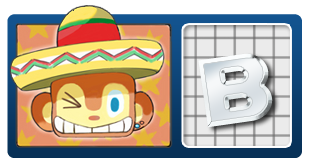 “A quirky compilation of SEGA titles. Flaws prevents it from being the best, but it’s still worth checking out for the bargain price and exclusive games.”
“A quirky compilation of SEGA titles. Flaws prevents it from being the best, but it’s still worth checking out for the bargain price and exclusive games.”SEGA 3D Classics Collection releases to the Nintendo 3DS in the Americas on April 26th.
Ad:

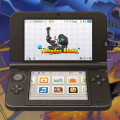
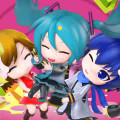


These games are enhanced ports. The larger SEGA compilations like Genesis Collection for PSP only had regular ports. More games is always ideal, but 9 games in this format is great.
Maze Walker is one of my most anticipated games. I rarely use the 3D effect. MW was built in 3D so the effect is perfectly put to use. I’m more interested in that experience than the length or gameplay depth.
Want boxed vol2 and 3? Also.
Any chance Puyo Puyo Tsu is translated?
Puyo Puyo Tsu is entirely in Japanese, but the digital manual and menus are translated in English.
Thanks very much for the response. Very sad that Sega didn’t translate the charming dialogue between characters, at least… I understand hacking arcade games takes some effort, but “quirks in localization” doesn’t sound like quite a solid reason for undermining a significant aspect of one of the main draws of this compilation.
It’s more because due to the hard coding on the Japanese text, text as images and stuff like that so it really requires a lot of work.
Yeah. Questionable sales predictions and all that. It’s still rather disappointing, though. At least they didn’t completely remove this game from the compilation, due to these “unpalatable” things (cf. Bare Knuckle’s/The Ooze’s/Comix Zone’s removal from previous Sega compilations a decade ago). Hopefully, Fantasy Zone is still in the code, unlockable if Vol. 1 is internationally released.
Nope.
Huh, it’s missing Fantasy Zone 1 from the volume 2 in Japan
that’s sucks 🙁
From my knowledge, that game unlocked when you had save data from vols 1 and 2. Not sure the game data is even on the cart.
Yeah, mine (vol 2, japanese version) got Fantasy Zone 1 automatically next to Fantasy Zone 2 since I already have the vol 1.
Good news, the SMS version of Fantasy Zone is indeed on the Americas release of the game! Check the above review for how to unlock it.
Not sure if I’m reading it wrong, but it seems like you are saying Power Drift only came out in arcades in Japan – it actually came out internationally. There was one at a mall near me when I was a kid (in Tennessee).